Small Cells
Wireless traffic is growing at a phenomenal rate. AT&T
says their cellular data traffic grew more than 80,000%
(that's 800 times) between 2007 (the introduction of the
iPhone) and 2017. The landscape is covered with cellular
towers but the capacity of these systems is inadequate for
planned traffic levels, especially as cellular service
providers move to 5G. Here
is why wireless is so much in the news - look at these
graphs from CTIA,
the US trade association for the wireless business, with
data from the end of 2016:
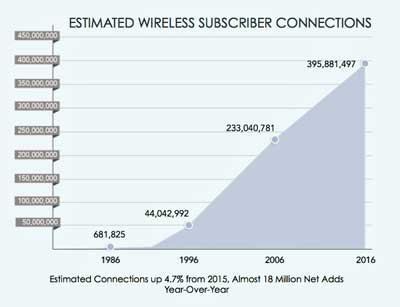
and the one below shows the wireless traffic growth:
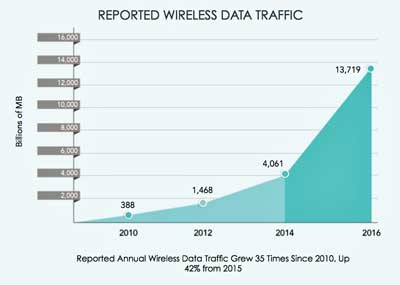
That looks like Internet growth 10-15 years ago. That kind
of growth gets attention because it means that service
providers have to invest in capacity - in wireless that
means fiber backbone and cell sites. The next graph shows
that growth - the number or cell sites in the US.
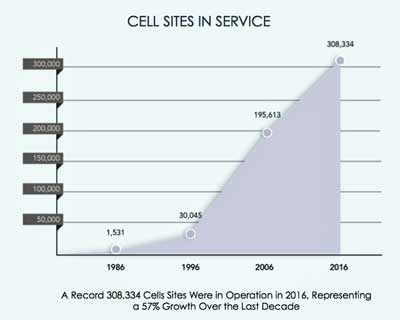
This data represents "traditional cell sites" - those
giant towers along roadways with big antennas at the top
or buildings with multiple antennas along the roofline.
You can see how the number of sites has grown in parallel
to the number of subscribers over the last two decades to
provide adequate coverage.
Today the focus is on "small cells." Small cells use much
lower power and cover much smaller areas - as shown
schematically in the graphic below. Generally small cells
will subdivide large cell areas to provide more local
service.
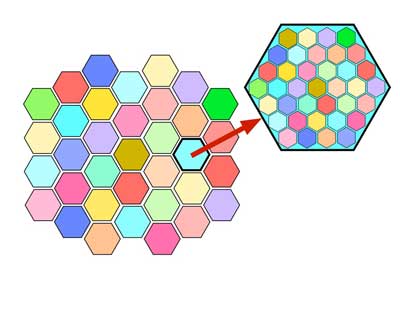
Regular cells (L) and small cells (R)
Small
cells have the advantage of being small and unobtrusive.
Cities have always had problems with cell coverage
because of the blocking of signals by large buildings
and many of the local citizens being against large, ugly
cell towers in their neighborhoods. Small cells look
like the ideal solution. They can be installed on light
poles, traffic signals or the side of buildings and are
small and almost unnoticeable.
Small
cells go by other names including micro-cells. They
are small, low-power, integrated radios and antennas
intended for small geographic areas. They typically
operate in the frequency range of 700MHz to 2.6GHz
with power outputs from <1W to 5W, much less than
regular cellular antennas. (5G has proposed to move
to frequencies >50GHz, but there are technical
problems at those frequencies.)
Small
cells are intended to be
be mounted on typical urban fixtures – walls, street
lights, traffic lights, bus stops, whatever gets
them slightly up off the ground. They only need a
single fiber and power to operate. The electronics
to control them is in a CO or head end, connected to
them by fiber.
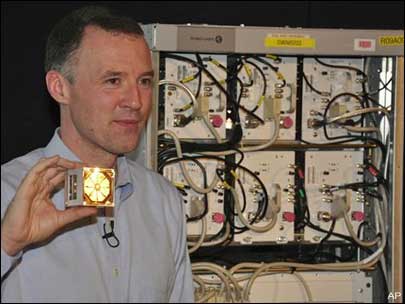
Alcatel-Lucent
pioneered the concept of the small cell when they
unveiled their LightCube Radio Small Cell in 2011.
Because small cells cover smaller areas than regular
cellular antennas, they will have fewer users
connecting to them to increase the bandwidth
available per user. Most will require only a single
SM fiber and DC power making installation easy where
municipal cable plants are available. Fiber
technology for installations is standard OSP and
premises – nothing new required. They can even use
PONs (passive optical networks - like FTTH) to
reduce the fiber needed and electronics near the
antenna. You can place several of these small cells
in one dome providing extended coverage over many
frequencies.
Look at what is happening in Santa Monica, CA. The Santa
Monica Seascape,
the city's newsletter for its citizens, recently ran
this article about small cells.
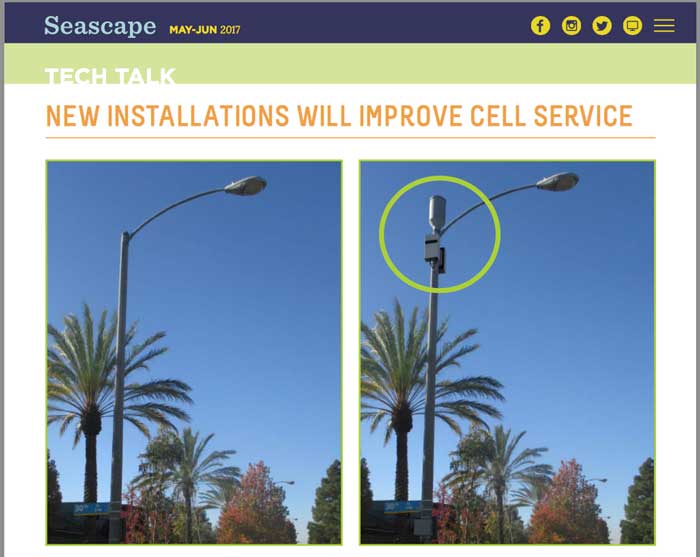
"In 2016, the City of Santa Monica adopted a new
wireless telecommunication ordinance to protect the city
from uncontrolled expansion, while streamlining the
review process to meet statutory deadlines. Adherence to
city design standards, compliance with Federal
Communications Commission (FCC) safety standards for
radio frequency emissions, and mail notification to
adjacent neighbors are all part of the local review and
approval process.
In response to the surge in customer data demands, the
private cellular industry has already begun preparing
for the deployment of micro-cell sites over the next few
years. Micro-cell equipment is often as small as a
toaster and, in Santa Monica, will be mounted to
existing light standards and telephone poles across the
city. These low-power, short-range devices (pictured
above) can process a lot of data very quickly. As the
systems go online, cell phone users will experience
fewer dropped calls, faster data transfer speeds and a
more reliable network.
An estimated 600 of these sites will be installed in
Santa Monica over the next five years."
We know Santa Monica and know the cellular coverage is
marginal in many parts of the city. At one point some
service providers were giving out personal "microcells"
that connected to your Internet in areas with poor
coverage. But the interesting thing is the number of
small cells that are estimated to be installed - 600 -
in a town that is only 8.4 square miles (about 22 square
km) and has a population of just over 90,000 people.
That's an antenna for every 150 people!
Within
the first year, more than 130 small cell permits were
taken.
Installing
all those small cells in Santa Monica is probably going
to be much easier than in many cities because of the
extensive metro network the city has installed. Santa
Monica CityNet has most of the city covered with large
fiber count underground cables and a network operating
at 100Gb/s - one of the world's fastest metro networks.
Walking the city streets, you are often seeing techs
splicing in new drops or working on the fiber
connections for the traffic controls.
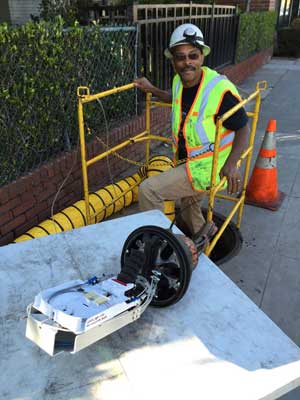
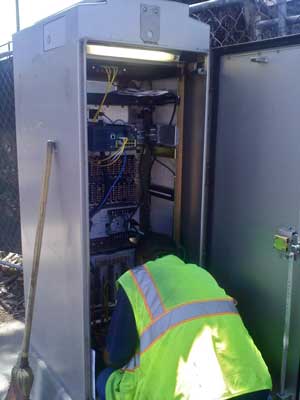
Palo Alto, CA was an early adopter of small cells and
they had a unique way of integrating them into the city
without being obtrusive. Here is an installation of a
small cell in Palo Alto. They
put the electronics in a mailbox like box and ran an
antenna up a street light! You can see the yellow
singlemode cable that connects the electronics in the
photo.


Other cities are also installing small cells. Below are
photos from downtown San Francisco of three different
types of small cells on street lights on Polk Street.
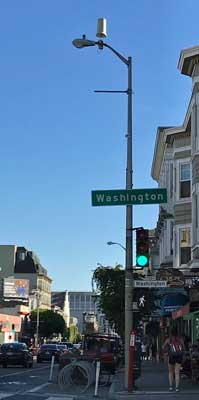

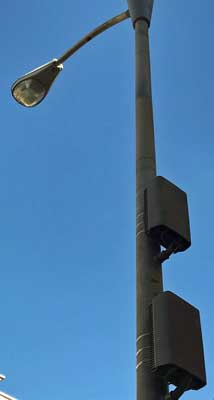
Boston also has a number of small cells installed.
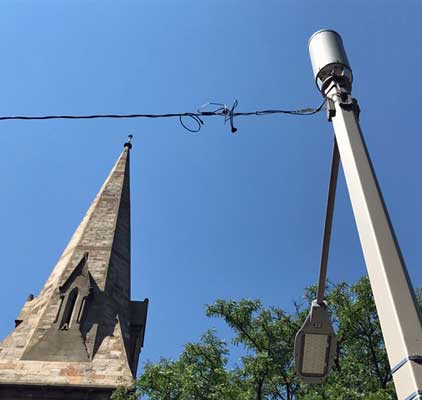
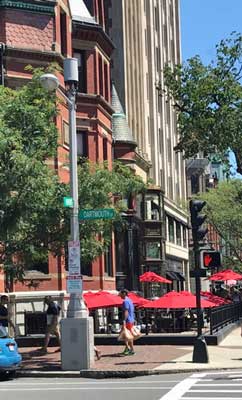
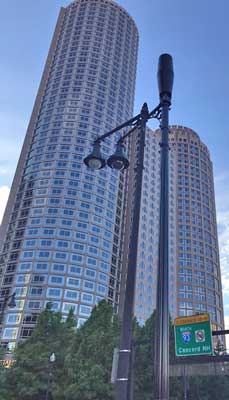
The city of Los Angeles has also been installing small
cells, but in some locations it is combining the small
cell with other innovative technology.
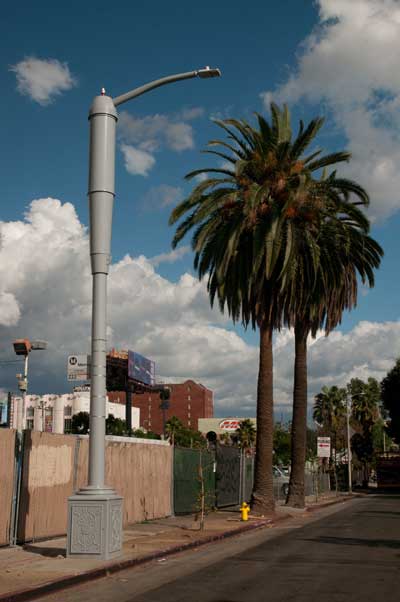
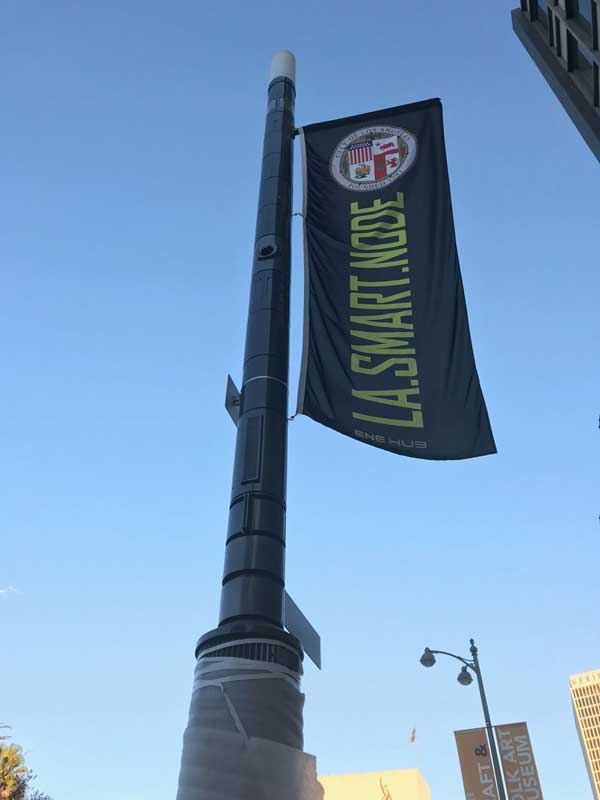
On the left is a new smart LED street light from Philips
with an Ericsson small cell in the wide part of the pole
near the top. On the right is a En-Hub, a radical new
pole with options for street lights (inside the pole,
not hanging off to the side), small cells, smart city
sensors and even a charging station for electric cars.
Small Cells On Fiber Backbones
Small cells are designed to operate on fiber backbones
directly from the small cell to a central office or head
end, similar to the "fronthaul" or "C-RAN" (Centralized
Radio Access Network) used with regular active antennas
on cell towers. That means that every small cell site
needs several fibers direct back to a central facility.
In
metro areas, that will require lots of fiber. If it's
not there, it will need to be installed. Some talk of
using PONs (passive optical networks used with fiber to
the home (FTTH) because it uses less fiber than
point-to-point links) to connect small cells.
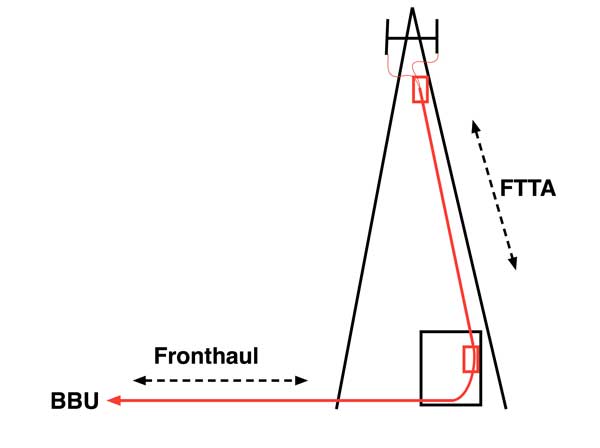
Cellular "Fronthaul" or "C-RAN" network has fiber going
from a central office/head end directly to the antenna.
Metropolitan networks to support small cells can be
shared with other services, including fiber to the home,
security systems, traffic systems, including vehicle to
vehicle (V2V) and vehicle to infrastructure (V2I)
communications. All this adds to the demand for fiber
optic communications to support the city of the future.
Articles have appeared both indicating the urgency to
install fiber (Deloitte)
and questioning if the parties involved have the
commitment and resources to actually build such networks
(Bloomberg.)
Evolution Of Small
Cells
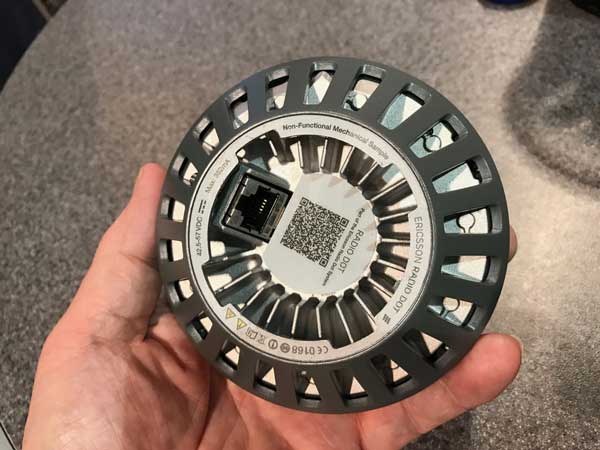
At a 2017 IWCE (wireless) conference, Ericsson had this
device in their booth. It's a small cell that connects
over Category 6 cable and is powered over the cable by
POE (power over Ethernet.), just like a wireless access
point. The implication seems to be that a DAS
(distributed antenna systems) can be the same as small
cells and even use conventional structured cabling like
WiFi. Interesting. Sharing premises (LAN) cabling could
make a big cost difference for the installation of
DAS in office buildings.
Learn more about how small cells and other technologies
contribute to "smart cities."
More
On Fiber For Wireless
FTTA- Fiber To The
Antenna
Testing FTTC
Fiber
DAS - Distributed
Antenna Systems
WiFi -
Premises Wireless
Comparing
WiFi, Small Cells and DAS.
|

